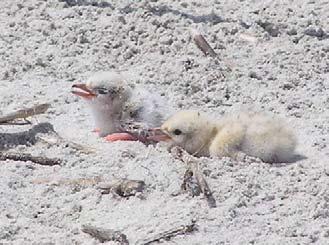
3 minute read
Georgia Beachs - For the Birds
An American oystercatcher with chick. Photo by Tim Keyes, GADNR
A Wilson Plover chick. Photo provided by GADNR
Advertisement

By Rick Lavender Communications and Outreach Specialist
GGADNR Wildlife Resources Division eorgia’s beaches are not only vacation hotspots, in spring and summer they’re top spots for nesting shorebirds and seabirds, and for migrating species fueling up for long fl ights to the Arctic.
American oystercatchers, Wilson’s plovers and least terns use sites such as Little Tybee Island, Pelican Spit off Sea Island, Cumberland Island and the southern end of Jekyll Island. Among other species, black skimmer, royal tern and gull-billed tern also nest on beaches and off shore sandbars.
In nesting areas, human disturbance is a signifi cant threat for these birds, which already face risks Least tern hatchlings. Photo provided by GADNR

from native predators and high spring tides. Adults frightened from a nest will often call loudly and exhibit distraction displays, such as dragging one wing as if it’s broken. Sometimes the birds will dive-bomb people too close to their nest, according to Tim Keyes, a Georgia Department of Natural Resources wildlife biologist.
Pets also can be destructive, killing or scaring birds. Leave dogs at home or keep them on a leash when visiting a beach where dogs are allowed. Owners who let their dogs chase shorebirds can be fi ned for harassing federally protected species. There are several coastal areas where pets are excluded and owners can be cited for bringing a dog. These sites include the entire beachfront portion of Little Tybee Island, Pelican Spit, Satilla Marsh Island, and St. Catherines Island and Little Egg Island bars. (The bars, Pelican Spit and Brunswick Dredge Island, are also closed to people.)
Beach-nesting birds nest above the high-tide line on wide, terraced beach fl ats or on the edges of dunes, laying eggs in shallow scrapes in the sand from mid-March through July. After hatching, chicks hide on the beach or in the grass. Disturbance by humans or pets can cause adult birds to abandon eggs and chicks, exposing them to extreme heat and predators.
Threats are similar for migrating seabirds and shorebirds. The coast provides vital stopover sites for species such as federally threatened red knots fl ying from South America and the Arctic. Red knots fl ushed from feeding might not gain the weight needed to survive their more than 9,000-mile migration.
“With a little bit of eff ort and concern, we all can enjoy the beach,” Keyes said. For example, a colony of least terns fl edged chicks on St. Simons’ popular East Beach last year. A Beach Stewards program powered by volunteers helps monitor the seabird colony there. Participants inform the public and ensure that dogs and beach-goers do not enter the roped-off colony. (Anyone interested in becoming a Beach Steward is encouraged to contact Keyes at 912-222-0424.)
As with all migratory bird species, shorebirds and seabirds in Georgia are protected by the federal Migratory Bird Treaty Act. Some species, such as piping plovers and red knots, have additional protections under the Endangered Species Act. A least tern feeding her chick. Photo by Tim Keyes, GADNR

BEACH BIRD TIPS How can you help birds when visiting a Georgia beach? • Stay in high-traffi c areas; birds are less likely to nest where crowds gather. • Walk below the high-tide line or on wet-sand beaches. • Avoid posted nesting sites. • Observe beach birds only from a distance. Back away from any nesting birds you accidentally disturb. • If you see people disturbing nesting birds, respectfully tell them how their actions can aff ect the birds. If they continue, contact DNR’s ranger hotline, (800) 241-4113 or rangerhotline@dnr.ga.gov. • Leave dogs at home or keep them on a leash when visiting a beach where they’re allowed. • Keep house cats indoors, and don’t feed feral cats. Cats often prey on birds.







